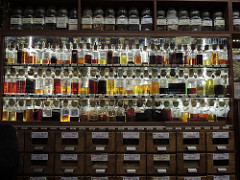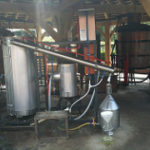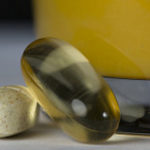An essential oil by definition is a concentrated, hydrophobic liquid containing volatile aroma compounds from plants. A hydrophobe is a molecule that is repelled from a mass of water. Other names for essential oils are volatile oils, ethereal oils, and aetherola; a very simplified definition is the oil of the plant from which it was extracted. Essential means that the oil carries a very distinctive scent of the plant from which it was obtained.
Most oils are obtained by the process of distillation. In this process the flowers, leaves, bark, roots, seeds, wood, and peel of the plant are put in a distilling apparatus then placed over water. The water is heated and the steam goes through the raw plant matter, vaporizing the volatile compounds. The resulting vapors then pass through a cooling coil which turns them back into a liquid (water) and collected in a separate container. This water is called a hydrosol or plant distillate and may be sold as another fragrance product, such as rose water. Lavender, rose, clary sage, lemon balm, and orange blossoms are common hydrosols.
Another method of obtaining these oils is by mechanical [removed]cold pressed). Most of the citrus scented oils are extracted by this method. Lemon and sweet orange essential oils are made this way. This method was the way all essential oils were produced before the advent of distillation.
The third way to obtain essential oils is by a process known as solvent extraction. A large number of floral scents are produced by this method because the flowers do not have a lot of volatile oil to be extracted and their chemical components are very fragile and easily broken down by the high heat used in steam distillation. Rather, a solvent is used to extract the oils. These extracts are called concretes, which are a mixture of essential oil, waxes, resins, and other oil soluble plant material. Although the concretes are highly fragrant, they contain material (resins, waxes, etc.) that are not fragrant and not needed. A second, different solvent (ethanol) is then used on the concretes which extracts only the fragrant molecules; when the ethanol evaporates an oil called the absolute remains. Absolutes are more fragrant than essential oils and a truer fragrance that is closer to the original plant is usually obtained. Trace amounts of the solvents are left in the absolute; therefore it is not considered appropriate for use in aromatherapy. The perfume industry, however, can and does use these absolutes to produce a fresher smell. Some examples of oils that are extracted by this third process are neroli, jasmine, mimosa and tuberose.
Producing the oils can be a simple or a more complex process. The variation in price of different essential oils depends on the extraction method used and the amount of the original plant material needed to make a significant amount of the essential oil. Precautions must be used when dealing with both essential oils and absolutes. Both are very concentrated and should be mixed with another carrier oil before being placed on the skin. (See 7 Important Facts You Absolutely Need To Know When Buying Essential Oils).
More and more people are turning to the essential oils and absolutes for their fragrance needs. There are so many different fragrances from which to choose-surely there is something for everyone!
The author is a registered nurse with 37+ years in the profession. Her interests include gardening, reading, and needlework. She also operates a web site called PeacefulBeing: the site is geared to natural and organic products. Items ranging from aromatherapy to bath and body products, soy candles, incense & potpourri, fragrance lamps/fuels are offered here, plus so much more. She would love to have you visit her site @ http://www.peacefulbeing.com/home.html










Leave a reply